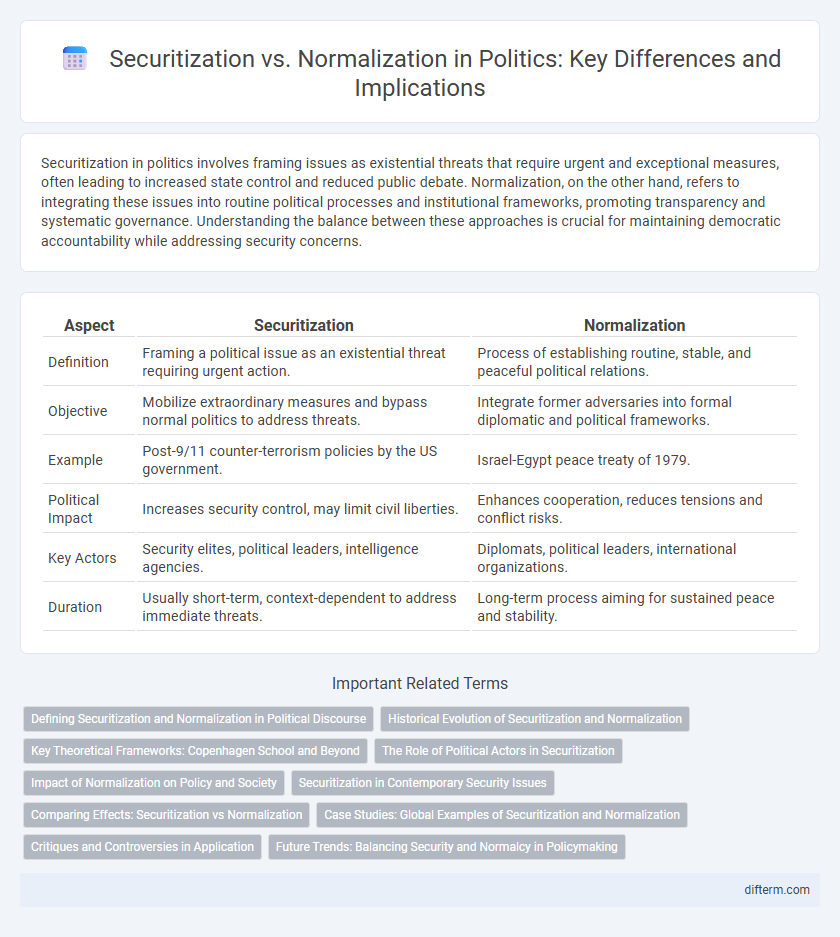Securitization in politics involves framing issues as existential threats that require urgent and exceptional measures, often leading to increased state control and reduced public debate. Normalization, on the other hand, refers to integrating these issues into routine political processes and institutional frameworks, promoting transparency and systematic governance. Understanding the balance between these approaches is crucial for maintaining democratic accountability while addressing security concerns.
Table of Comparison
| Aspect | Securitization | Normalization |
|---|---|---|
| Definition | Framing a political issue as an existential threat requiring urgent action. | Process of establishing routine, stable, and peaceful political relations. |
| Objective | Mobilize extraordinary measures and bypass normal politics to address threats. | Integrate former adversaries into formal diplomatic and political frameworks. |
| Example | Post-9/11 counter-terrorism policies by the US government. | Israel-Egypt peace treaty of 1979. |
| Political Impact | Increases security control, may limit civil liberties. | Enhances cooperation, reduces tensions and conflict risks. |
| Key Actors | Security elites, political leaders, intelligence agencies. | Diplomats, political leaders, international organizations. |
| Duration | Usually short-term, context-dependent to address immediate threats. | Long-term process aiming for sustained peace and stability. |
Defining Securitization and Normalization in Political Discourse
Securitization in political discourse refers to the process by which political actors frame an issue as a significant security threat, justifying extraordinary measures beyond normal political procedures. Normalization, conversely, involves the integration of contentious or previously exceptional issues into routine political debate and governance, minimizing their perceived existential threat. Understanding securitization and normalization is crucial for analyzing how states prioritize policies and manage public perception of security challenges.
Historical Evolution of Securitization and Normalization
Securitization emerged during the Cold War as states framed existential threats to justify extraordinary measures, embedding a logic of emergency and exception in political discourse. Normalization, in contrast, reflects the process of integrating once-framed security issues back into routine political debate and policy, often occurring post-conflict or as crises stabilize. The historical evolution of securitization and normalization illustrates a cyclical pattern where security threats are first amplified to mobilize support or legitimize power, then gradually redefined to restore conventional governance and civil order.
Key Theoretical Frameworks: Copenhagen School and Beyond
The Copenhagen School's securitization theory emphasizes the process by which political actors frame issues as existential threats to justify extraordinary measures, challenging the boundaries of normal political discourse. In contrast, normalization involves integrating formerly securitized issues into routine politics, reducing perceived urgency and exceptionalism. Beyond the Copenhagen School, frameworks incorporate poststructural and critical perspectives that analyze power dynamics and discourse in the shifting securitization-normalization continuum.
The Role of Political Actors in Securitization
Political actors play a crucial role in securitization by framing issues as existential threats that require extraordinary measures. Through speeches, legislation, and media engagement, they construct and legitimize security narratives to mobilize public support and justify exceptional policies. Their influence determines whether an issue is escalated into a security concern or maintained within the bounds of normal political discourse.
Impact of Normalization on Policy and Society
Normalization in politics shifts government policies from emergency measures to standard governance, promoting stability and predictability in legislative frameworks. This process often results in the reintegration of previously marginalized groups, fostering social cohesion and long-term peacebuilding. Policy implications include reduced state surveillance and militarization, enabling increased civil liberties and democratic participation.
Securitization in Contemporary Security Issues
Securitization in contemporary security issues involves framing certain political challenges as existential threats, thereby justifying extraordinary measures and bypassing standard political procedures. This process amplifies political urgency around topics such as terrorism, migration, and pandemics, often leading to increased state power and reduced civil liberties. Critics argue securitization can exacerbate social divisions and prioritize militarized responses over diplomatic solutions.
Comparing Effects: Securitization vs Normalization
Securitization frames a political issue as an existential threat, prompting urgent security measures that often restrict civil liberties and justify extraordinary government powers. Normalization, conversely, integrates issues into routine political discourse, encouraging democratic deliberation, transparency, and gradual policy adjustments. While securitization can lead to heightened social tensions and authoritarian tendencies, normalization fosters stability and public trust by treating problems as manageable within existing institutional frameworks.
Case Studies: Global Examples of Securitization and Normalization
Global case studies reveal diverse approaches to securitization, such as the U.S. post-9/11 security measures, which intensified surveillance and military interventions, contrasting with the European Union's normalization efforts through diplomatic engagement with Iran leading to the 2015 nuclear deal. South Africa's transition from apartheid to democracy exemplifies normalization by institutionalizing human rights and reconciliation rather than securitizing dissent. These examples illustrate how securitization often escalates conflict and restricts freedoms, while normalization promotes stability and cooperative international relations.
Critiques and Controversies in Application
Securitization often faces criticism for enabling disproportionate state power by framing issues as existential threats, which can justify extraordinary measures undermining democratic norms. Normalization, while promoting routine governance, is challenged for potentially downplaying genuine risks and facilitating complacency in security practices. Both approaches spur controversy over balancing security needs with civil liberties, raising debates on the appropriate limits of political rhetoric and policy action.
Future Trends: Balancing Security and Normalcy in Policymaking
Future trends in policymaking emphasize balancing securitization measures with normalization strategies to ensure long-term political stability and public trust. Increasing reliance on data-driven decision-making and adaptive governance models will shape security protocols without compromising civil liberties. Policymakers are expected to prioritize resilient frameworks that integrate security concerns with democratic norms to address evolving geopolitical challenges.
Securitization vs Normalization Infographic

 difterm.com
difterm.com